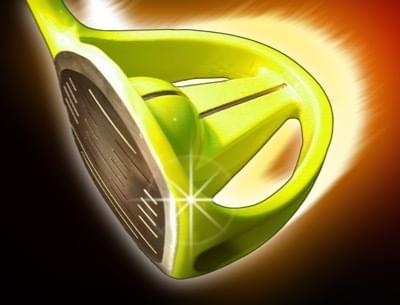

We've made a number of assumptions for each of these swings. Launch it higher for more carry distance and more roll. At this swing speed, the higher we can launch the ball the better because the ball will stay in the air longer. This shot gets 232 yards of carry and 22 yards of roll on a typical PGA Tour-cut fairway. Now we can start to get a lot of distance. We're going to catch it high on the face and 5-6° on the upswing instead of 2°. We've teed it super high, it's way up in our stance.
Long ball air hammer golf club software#
Now we've told the software that we're going to launch the ball extremely high. Shot C shows what happens if we catch the ball severely on the upswing. We do pick up a couple yards of roll, but two yards of roll obviously doesn't make up for losing 22 yards of carry. That shot launched very low, got lower spin because there was less dynamic loft at impact, and now we're only getting 200 yards of carry. Shot B is the red one, where we hit down by a couple of degrees. (We'll calculate the roll on these shots in a few minutes.) With just a little bit of swing instruction such as the Launch Angle lesson, we've picked up 20 yards of carry. The yellow swing now carries 220.4 yards, and all we did was change is the launch angle. If we back the dynamic loft down as well we can get a direct comparison. Ball speed and club head speed have remained the same. Our carry distance goes from 199.7 to 222.7.

With a little more forward kick in the shaft, we get a launch angle of 13° with a similar ball speed. It gives a little more dynamic loft, which will increase the spin a little bit. That's catching the ball slightly on the upswing. On the yellow shot we've changed the angle of attack to positive 2.5°. Let's see what happens when we change some of the factors on that swing.
Long ball air hammer golf club how to#
The driver has become more and more of a specialty club and you need to learn how to maximize it. Review the launch angle lesson and work on getting a higher launch with the driver. It's the only club in the bag without a distance or a speed limit on it. It's designed to be hit as long as you can. This angle of attack, this club head speed and this ball speed don't create enough spin to keep the ball in the air long enough to go anywhere. Of course, we're all imperfect and we don't hit the ball flush every time so it's not even going to go that far. We can see on the graph that the red shot only carried about 200 yards, and that's if we hit it absolutely flush. When you're swinging at 95 mph and your launch angle is that low, the ball is just not going to go very far. Even with a negative angle of attack of just 2° - which isn't even all that sharp - the ball is only going to launch at 7°. Hitting down on the ball will cost you massive, massive distance. A lot of golfers have been taught to do exactly this, but for the average golfer it's terrible advice. We're hitting down on the ball with this driver as if it were an iron shot. The bad news is, we came into impact with an angle of attack of -2°. If we have 10.5° of dynamic loft on the club and we got a good, solid shot, why did it fly so low? Simulation software shows us a graph of several sample shots Why So Low? We're swinging at 95 miles an hour, and we'll assume we're hitting the ball solidly in the center of the face and getting a good power transfer ratio. For our example we'll assume that, whatever the factors, the net effect is 10.5° for this particular club. The way the shaft flexes forward at impact can also affect the launch angle. The club may say 9.5° but actually measure out to 10.5°. That doesn't necessarily mean that the driver says 10.5° on the heel. This line represents a swing with a dynamic loft of 10.5°. We'll start with the red one at the bottom. The graph below shows a simulation of three similar swings. Those two factors together are going to cost you a lot of distance. If you're swinging that club head in the 95 mile an hour range and you hit it low on the face, you're only getting 7° of loft at impact, coupled with a tremendous amount of spin. Assuming it's in spec to begin with, which they're usually not, if you take a loft/lie gauge and measure the bottom of the face you may find that it only has 7° of loft at that point. In the next lesson we talked about the "roll" or curvature built into club face. We started with that lesson because where the ball strikes the club face affects distance more than anything else. Think back to the Ball Speed lesson, when we marked the ball with a dry erase marker to find out where it was hitting the club face. Ideally, you want a high launch angle and low spin. Hitting the ball solidly just above the center of the club face will reduce spin, which is good.


 0 kommentar(er)
0 kommentar(er)
